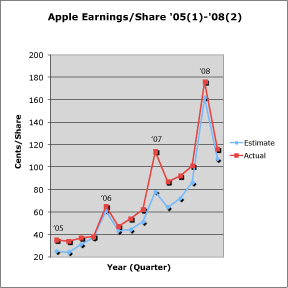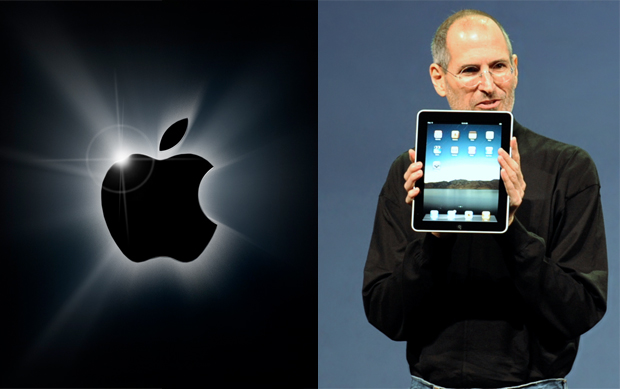Apple Report
Apple's iTunes software can be used to transfer music to the devices from computers using certain versions of Apple Macintosh and Microsoft Windows operating systems. For users who choose not to use iTunes or whose computers cannot run iTunes, several open source alternatives are available for the iPod. iTunes and its alternatives may also transfer photos, videos, games, contact information, e-mail settings, Web bookmarks, and calendars to iPod models supporting those features.
Discontinued models of the line include the iPod Mini and the iPod Photo, the former being replaced by the iPod Nano, and the latter reintegrated into the main iPod line (now the iPod Classic).
The iPod line came from Apple's "digital hub" category, when the company began creating software for the growing market of personal digital devices. Digital cameras, camcorders and organizers had well-established mainstream markets, but the company found existing digital music players "big and clunky or small and useless" with user interfaces that were "unbelievably awful," so Apple decided to develop its own. As ordered by CEO Steve Jobs, Apple's hardware engineering chief Jon Rubinstein assembled a team of engineers to design the iPod line, including hardware engineers Tony Fadell and Michael Dhuey, and design engineer Jonathan Ive. The product was developed in less than one year and unveiled on October 23, 2001. Jobs announced it as a Mac-compatible product with a 5 GB hard drive that put "1,000 songs in your pocket."
Apple did not develop the iPod software entirely in-house, instead using PortalPlayer's reference platform based on two ARM cores. The platform had rudimentary software running on a commercial microkernel embedded operating system. PortalPlayer had previously been working on an IBM-branded MP3 player with Bluetooth headphones. Apple contracted another company, Pixo, to help design and implement the user interface under the direct supervision of Steve Jobs. As development progressed, Apple continued to refine the software's look and feel. Starting with the iPod Mini, the Chicago font was replaced with Espy Sans. Later iPods switched fonts again to Podium Sans—a font similar to Apple's corporate font, Myriad. iPods with color displays then adopted some Mac OS X themes like Aqua progress bars, and brushed metal meant to evoke a combination lock. In 2007, Apple modified the iPod interface again with the introduction of the sixth-generation iPod Classic and third-generation iPod Nano by changing the font to Helvetica and, in most cases, splitting the screen in half by displaying the menus on the left and album artwork, photos, or videos on the right (whichever was appropriate for the selected item).
In September 2007, during a lawsuit with patent holding company Burst.com, Apple drew attention to a patent for a similar device that was developed in 1979. Kane Kramer applied for a UK patent for his design of a "plastic music box" in 1981, which he called the IXI. He was unable to secure funding to renew the US$ 120,000 worldwide patent, so it lapsed and Kramer never profited from his idea.
The name iPod was proposed by Vinnie Chieco, a freelance copywriter, who (with others) was called by Apple to figure out how to introduce the new player to the public. After Chieco saw a prototype, he thought of the movie 2001: A Space Odyssey and the phrase "Open the pod bay door, Hal!", which refers to the white EVA Pods of the Discovery One spaceship. Chieco saw an analogy to the relationship between the spaceship and the smaller independent pods in the relationship between a personal computer and the music player. Apple researched the trademark and found that it was already in use. Joseph N. Grasso of New Jersey had originally listed an "iPod" trademark with the U.S. Patent and Trademark Office (USPTO) in July 2000 for Internet kiosks. The first iPod kiosks had been demonstrated to the public in New Jersey in March 1998, and commercial use began in January 2000, but had apparently been discontinued by 2001. The trademark was registered by the USPTO in November 2003, and Grasso assigned it to Apple Computer, Inc. in 2005.
Discontinued models of the line include the iPod Mini and the iPod Photo, the former being replaced by the iPod Nano, and the latter reintegrated into the main iPod line (now the iPod Classic).
The iPod line came from Apple's "digital hub" category, when the company began creating software for the growing market of personal digital devices. Digital cameras, camcorders and organizers had well-established mainstream markets, but the company found existing digital music players "big and clunky or small and useless" with user interfaces that were "unbelievably awful," so Apple decided to develop its own. As ordered by CEO Steve Jobs, Apple's hardware engineering chief Jon Rubinstein assembled a team of engineers to design the iPod line, including hardware engineers Tony Fadell and Michael Dhuey, and design engineer Jonathan Ive. The product was developed in less than one year and unveiled on October 23, 2001. Jobs announced it as a Mac-compatible product with a 5 GB hard drive that put "1,000 songs in your pocket."
 Apple Q2 2008 financial report |  Apple Earnings Q2 08 |  Apple is poised to reach a |  Apple Analyst Report: |  Apple Earnings Call Starts |
 Why Apple\x26#39;s Earnings Reports |  Apple Q3 earnings report |  At today\x26#39;s earnings call, |  Good as Q1 Earnings Report |  Apple-Earnings-Q1-2010 |
The name iPod was proposed by Vinnie Chieco, a freelance copywriter, who (with others) was called by Apple to figure out how to introduce the new player to the public. After Chieco saw a prototype, he thought of the movie 2001: A Space Odyssey and the phrase "Open the pod bay door, Hal!", which refers to the white EVA Pods of the Discovery One spaceship. Chieco saw an analogy to the relationship between the spaceship and the smaller independent pods in the relationship between a personal computer and the music player. Apple researched the trademark and found that it was already in use. Joseph N. Grasso of New Jersey had originally listed an "iPod" trademark with the U.S. Patent and Trademark Office (USPTO) in July 2000 for Internet kiosks. The first iPod kiosks had been demonstrated to the public in New Jersey in March 1998, and commercial use began in January 2000, but had apparently been discontinued by 2001. The trademark was registered by the USPTO in November 2003, and Grasso assigned it to Apple Computer, Inc. in 2005.
 Apple Earnings Call |  Apple earnings report shows |  Apple-earnings.jpg |  Jason Mask Scary Pumpkin |  Free, Printable Halloween |






0 Comments:
Post a Comment
Subscribe to Post Comments [Atom]
<< Home